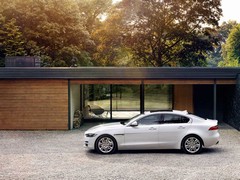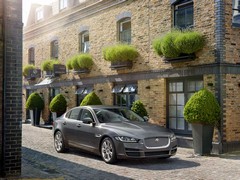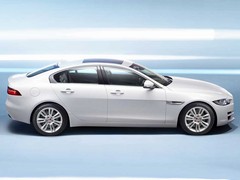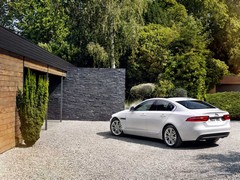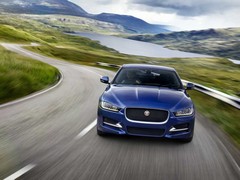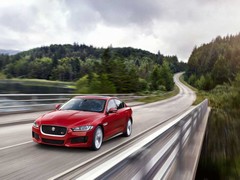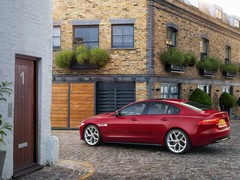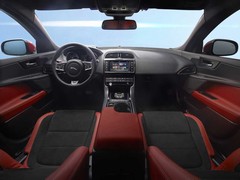Jaguar XE - the full range
Prices, weights, specs - get your fill here!
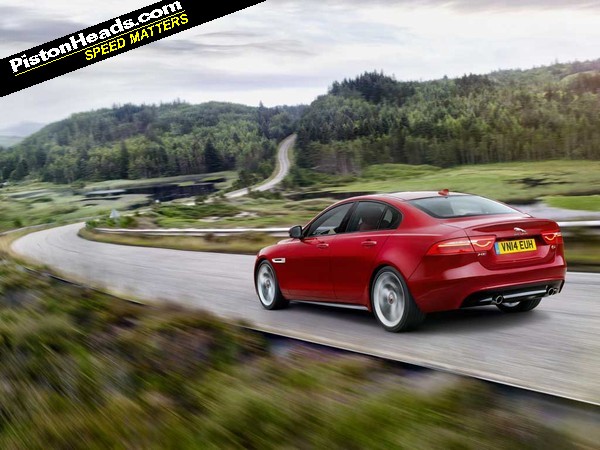
The Jaguar XE range starts at £26,995 for the 200hp 2.0-litre turbo SE. The diesels begin at £29,775 for the 163hp 2.0d with a manual 'box. For reference that's £1,000 more than a 320d SE. The 340hp XE S is the fastest and most expensive XE at launch, costing £44,870.
Then we're into the quirks of specifications. Both diesels are available with every trim level (SE, Prestige, R-Sport and Portfolio), the 200hp petrol as an SE, Prestige or R-Sport and the 240hp petrol only as an R-Sport or Portfolio. The supercharged V6 gets its own 'S' spec. The diesels have the choice of manual or automatic 'boxes, the petrols are auto-only. Still with us?
Right. So if you opt for for an XE SE you'll get 'high-quality cloth seats' and 'black treatment for the door trim finishers' as well as standard DAB radio, sat-nav and cruise control. Prestige adds leather upholstery and aluminium trim. Portfolio is the most luxurious XE with softgrain leather, electric seats, Meridian audio and bi-xenon lights.
An R-Sport XE can be identified through a 'noble chrome treatment for the side power vents' (really). There's a small rear spoiler too plus standard sports suspension (no details on that yet) with sports seats too. Sporty. If the V6 noise doesn't mark out an XE S enough, it features a gloss black rear valance, 19-inch wheels and red calipers. And breathe.
Prices? Prestige adds £1,000 to SE, R-Sport is £1,750 more than the Prestige and Portfolio is £650 on top of the R-Sport. The automatic costs £1,750 on the diesels which are separated by £500 spec for spec. There's £3,350 between the 200hp R-Sport and the 240hp version.
And as we're on numbers we should deal with kerbweights as well. The 163hp diesel is 'from 1,474kg', the 180hp version a fair bit more at 1,550kg. The pair of 2.0-litre petrols are near identical (1,530kg for the 200 and 1,535kg for the 240). The V6 S is nearly 200kg heavier than the diesel at 1,665kg. Let's see what the road test scales say.
We would be here all day detailing the spec of each XE so let's focus on the 163hp diesel that will likely be the most popular. You'll need the manual to hit those headline 99g/km/75mpg stats, the auto adding another 5g/km and dropping the official EU combined to 71.7. The ZF gearbox takes two tenths from the 0-62mph time (down to 8.2 seconds) but top speed in both is 132mph.
Jaguar isn't quite done on the technology debuts either. The latest is All Surface Progress Control (ASPC) which Jaguar describes as 'akin to a low-speed cruise control' and a feature that will give the XE 'unrivalled all-weather capability' amongst its RWD rivals. It uses Land Rover tech to gain traction more swiftly than a driver can and functions between 2 and 19mph. Set it like cruise control and just focus on steering. Only if you have the automatic gearbox though.
The usual roster of driver assist systems feature in the XE with a few notable inclusions. The optional head-up display is by laser and the autonomous emergency braking uses a stereo camera to create a 3D view of the road ahead. Don't forget the XE app too that will allow you to open doors remotely, check fuel level, set the climate control and so on.
So that's the latest on the Jaguar XE. The driving impressions are coming as soon as possible, honest.
There is an argument to say that an aluminium BIW can have a higher specific stiffness, but tbh, modern cars are "stiff enough" even when made of out steel, so there is not really much advantage there either (despite what all the marketing nonsense about "doubled torsional stiffness over the last model" etc might spout!
I do hope that this car gives Jag a decent chunk of revenue. It's impressive what they have acheived given the volumes the Germans ship in comparison.
Gassing Station | General Gassing | Top of Page | What's New | My Stuff

